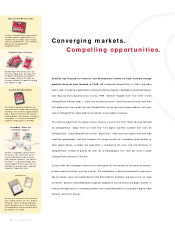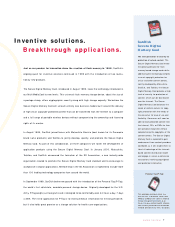SanDisk 1999 Annual Report Download - page 17
Download and view the complete annual report
Please find page 17 of the 1999 SanDisk annual report below. You can navigate through the pages in the report by either clicking on the pages listed below, or by using the keyword search tool below to find specific information within the annual report.
14 Annual Report 1999
MANAGEMENT’S DISCUSSION AND ANALYSIS
In 1998, our product revenues were $103.2 million, a decline of
2% from $105.7 million in 1997. The 1998 decrease consisted of
an increase in unit shipments of 34% which was offset by a decline
in average selling prices of 28%. In 1998, the largest increase in
unit volume came from sales of CompactFlash products, primarily
for use in digital cameras and other consumer electronics applica-
tions. CompactFlash products represented approximately 50% of
product revenues in 1998.
SanDisk’s backlog at the end of 1999 was $157.2 million compared to
$13.4 million in 1998 and $18.6 million in 1997. See “Factors That
May Affect Future Results — Our operating results may fluctuate
significantly” and “ — There is seasonality in our business.”
LICENSE AND ROYALTY REVENUES.
We currently earn patent license fees and royalties under seven
cross-license agreements with Hitachi, Intel, Sharp, Samsung,
SmartDisk, SST and Toshiba. License and royalty revenue from
patent cross-license agreements was $41.2 million in 1999, up
from $32.6 million in 1998 and $19.6 million in 1997. The
increase in license and royalty revenues in 1999 was primarily due
to an increase in patent royalty revenues. The increase in license
and royalty revenues in 1998 was partially due to the recognition of
a full year of revenues under the Hitachi, Toshiba and Samsung
agreements, which were entered into in the third quarter of 1997.
Revenues from licenses and royalties were 17% of total revenues in
1999, 24% in 1998 and 16% in 1997.
GROSS PROFITS.
In fiscal 1999, gross profits increased to $94.8 million, or 38.4% of
total revenues from $55.5 million, or 40.8% of total revenues in
1998 and $53.0 million, or 42.3% of total revenues in 1997. In
1999, product gross margins increased to 26.1% of product revenues
from 22.2% in 1998, primarily due to the lower cost per megabyte
of our 256 megabit and 128 megabit flash memory products, which
began shipping in volume in the second half of 1999. We expect
product gross margins to improve from the 1999 level in the first
quarter of 2000 as we transition to our 256 megabit technology for
the majority of our product sales.
In 1998, the growth in overall gross profits resulted from an increase
in license and royalty revenues, which was partially offset by a decline
in gross profit from product sales. Product gross profits declined as a
percentage of product revenues to 22.2% in 1998 compared to
31.6% in 1997, primarily due to competitive pricing pressures.
RESEARCH AND DEVELOPMENT.
Research and development expenses consist principally of salaries
and payroll related expenses for design and development engineers,
prototype supplies and contract services. Research and development
expenses increased to $26.9 million in 1999 from $18.2 million in
1998 and $13.6 million in 1997. As a percentage of revenues,
research and development expenses represented 10.9% in 1999,
13.4% in 1998 and 10.8% in 1997. In 1999 and 1998, the
increase in research and development expenses was primarily due to
an increase in salaries and payroll-related expenses associated with
additional personnel and higher project related expenses. Increased
depreciation due to capital equipment additions also contributed to
the growth in research and development expenses in both years. We
expect research and development expenses to continue to increase,
in absolute dollars and perhaps as a percentage of revenue, to sup-
port the development of new generations of flash data storage
products, including the proposed 512 megabit and 1 gigabit flash
memory co-development and manufacturing joint venture with
Toshiba. If we successfully enter ito a definitive agreement with
Toshiba, we expect the incremental research and development
expenses related to the Toshiba joint development project to be in
the range of $6.0 million to $8.0 million in fiscal 2000.
SALES AND MARKETING.
Sales and marketing expenses include salaries, sales commissions,
benefits and travel expenses for our sales, marketing, customer serv-
ice and applications engineering personnel. These expenses also
include other selling and marketing expenses, such as independent
manufacturer’s representative commissions, advertising and
tradeshow expenses. Sales and marketing expenses increased to
$25.3 million in 1999 from $16.9 million in 1998 and $12.6 mil-
lion in 1997. The increase in 1999 was primarily due to increased
salaries and payroll related expenses and increased commission
expenses due to higher product revenues and increased marketing
expenses. The increase in 1998 was primarily due to increased mar-
keting and sales expenses related to the development of the retail
channel. Increased salaries and payroll related expenses associated
with additional personnel also contributed significantly to the
increase in 1998. Sales and marketing expenses represented
10.2% of total revenues in 1999 compared to 12.5% in 1998 and
10.0% in 1997. We expect sales and marketing expenses to
increase as sales of our products grow and as we further develop the
retail channel for our products.
























